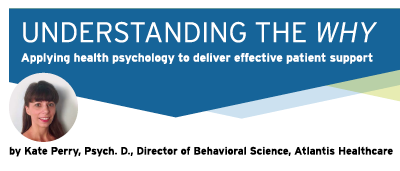 Understanding The Why
Understanding The Why
Applying health psychology to deliver effective patient support
As a health and clinical psychologist, I’ve spent the last ten years helping the healthcare industry address the self-management needs of patients living with long-term conditions. For the most part, this work has involved collaborating with pharma to support patients to take their medication as prescribed.
Over this time, I’ve come to truly appreciate that the translation of psychological theory and research into commercial practice is not always straightforward. it often demands thinking both practically and creatively, with a willingness to make compromises to accommodate real-world constraints.
I see four main areas where psychological theory and research can be most readily applied to help pharma optimize medication adherence:
1. Health psychology can help pharma explore and identiry the reasons why an individual may be nonadherent.
Pharma often has insights into when a patient may drop off a medication, or what “type” of patient might do this, based on their own segmentation research, but they do not typically understand why this happens. Understanding the why behind medication nonadherence is a crucial first step in designing effective support programs. Health psychology tells us that the why is often grounded in a patient’s beliefs about their condition and treatment, and provides us with theories to make sense of these beliefs. Ultimately this understanding of why enables the development of interventions that can effectively address those beliefs that are incompatible with adherence.
2. Once the whys are understood, health psychology can help pharma develop patient programs that are interventional and actively work to support adherence.
In our information-saturated, time-poor lives, patient communications need to work harder to engage their audiences. Simply providing information and education on disease and treatment is not enough to change behavior over the long-term, and fails to help patients acquire the skills necessary to persist with treatment. Health psychology can support patient behavior change and skill development by embedding evidence-based behavior change techniques (BCTs) into patient communications.
3. As pharma increasingly partners with Hub services and Specialty Pharmacy to help patients navigate treatment access and reimbursement, health psychology can be applied to build the communication skills of these teams, with a focus on those skills that reflect empathy and patient-centricity.
It can also be used to expand traditional services so telephone support is provided to patients throughout their treatment journey, not just at treatment initiation. Used this way, health psychology-based training could include the application of behavior change techniques (BCTs), and other appropriate therapeutic approaches such as solution-focused therapy.
4. Health psychology can help pharma develop and maintain a strong doctor-patient relationship, which can have a significant impact on medication adherence.
Appreciating this is a two-way dialogue, health psychology can support the development of both doctor and patient-facing materials while ensuring they address the needs of both. Specifically, health psychology can help doctors understand how important the patient perspective is in driving future adherence, and can suggest the sorts of questions and responses doctors may wish to apply to elicit the patient perspective on their condition and treatment. From the patient perspective, health psychology can be leveraged to support patients to acquire the skills necessary to be an active participant in the interaction with their doctor. This could include supporting in the interaction with their doctor. This could include supporting patients to express their needs and feelings, be more assertive in what they want from the interaction, and ask clarifying questions.
While the translation of theory into practice always presents a challenge, there are several areas where health psychology theory has been, and can be, effectively applied in real-world circumstances to support pharma. The key to this application is to first understand the why behind treatment nonadherence for a specific population, and to then develop supportive interventions – through print or digital channels, via telephone-based services or face-to-face interactions – that actively address this why.










